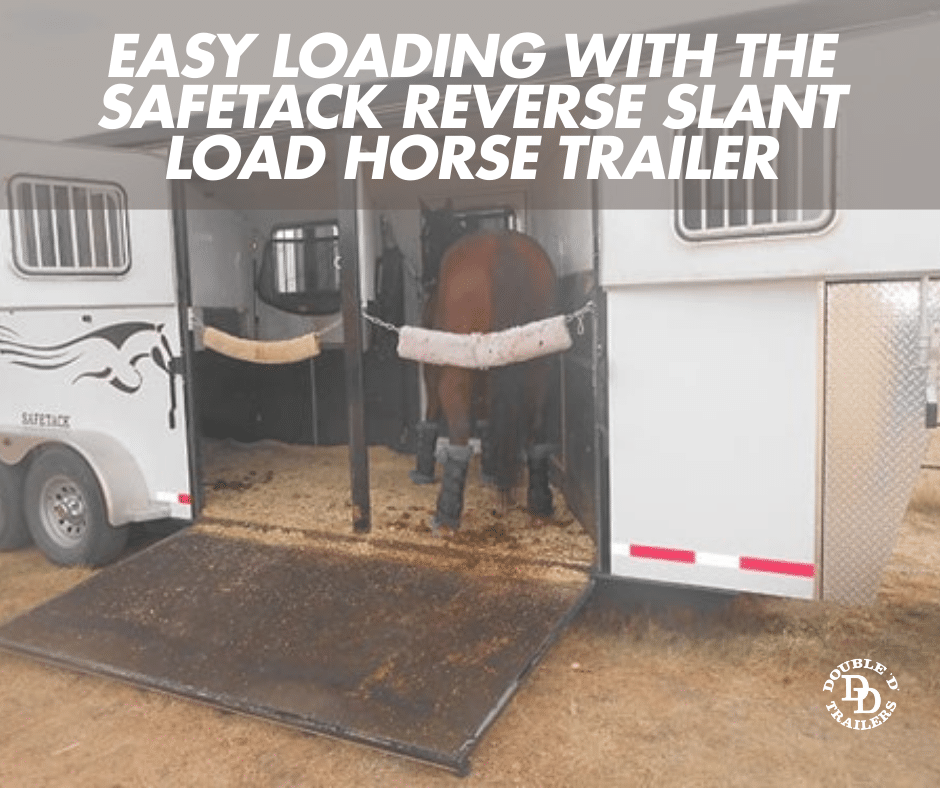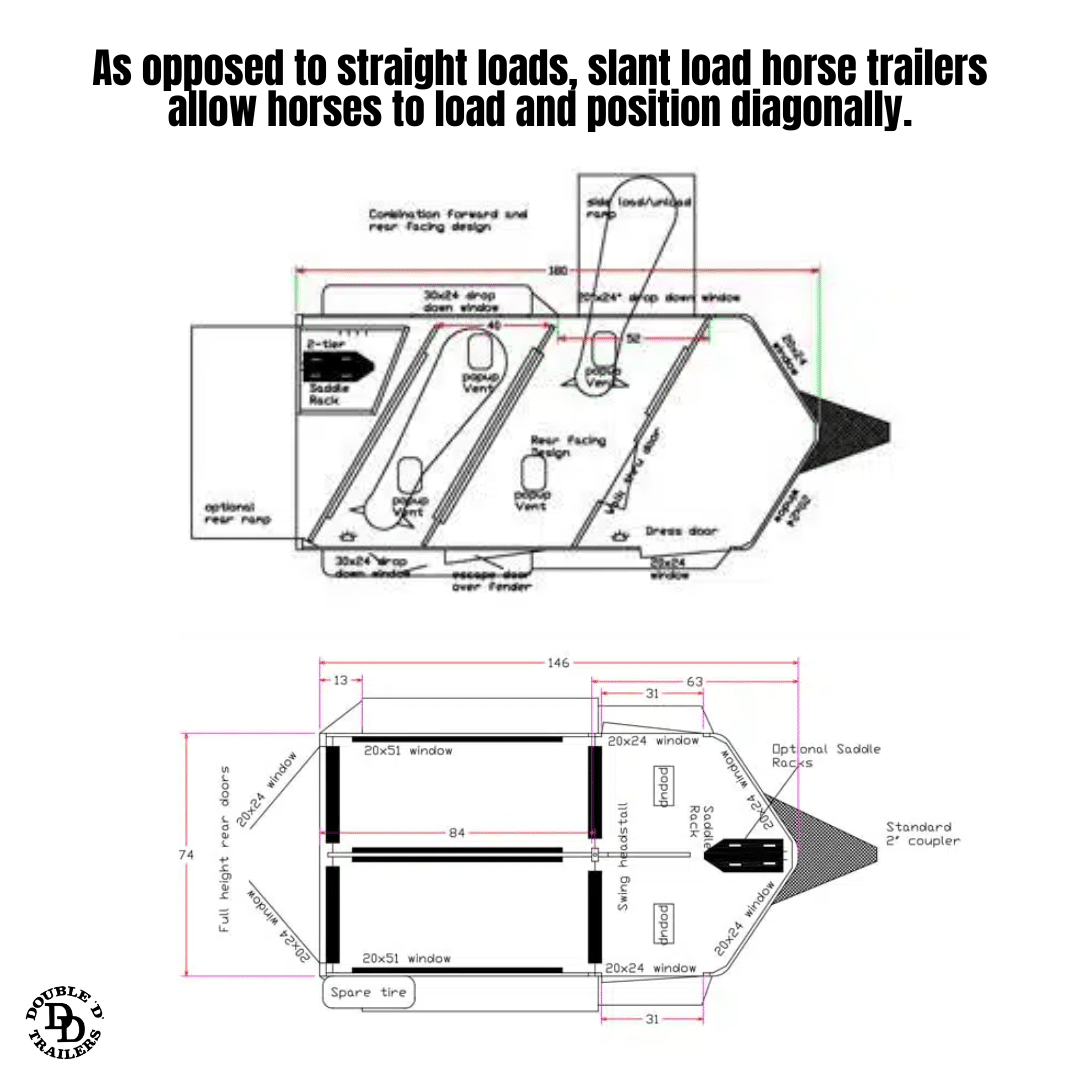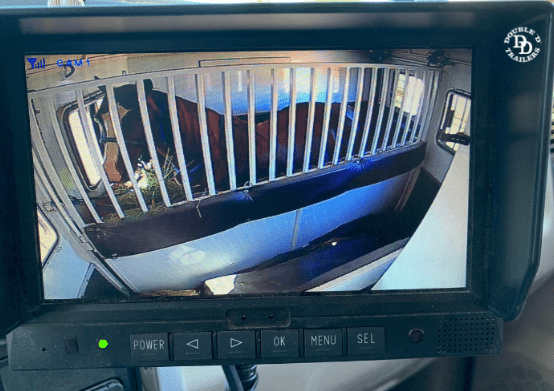Straight Load or Slant Load Horse Trailer: Which is Better?
What are slant load horse trailers and how do they function?
Slant load trailers, such as those offered by Double D Trailers, incorporate a patented SafeTack design, optimizing safety, comfort, and convenience for both horses and handlers. This design features an enclosed tack storage area that swings out, creating a wide, open entryway for loading, minimizing the risk associated with narrow passages.
Why are straight load horse trailers preferred by some owners?
Straight load trailers are traditionally favored for their simplicity and ease of use. In these trailers, horses are walked directly into stalls and secured, a process familiar to many owners. However, this can pose challenges with unruly horses, leading to safety risks during loading and unloading.
How does the design of each trailer type impact horse comfort during transport?
It seems when horses are traveling in a straight load they tend to balance themselves on both their front and rear feet equally. It stands to reason fatigue is distributed more evenly on all four feet and legs.
When traveling in a slant load, the balance is shifted more towards the front right and left rear (depending on the direction of the slant). So, if you are traveling a three-day nonstop journey from North Carolina to California, your horses may favor the front right and left rear from greater fatigue compared to the other two legs for a short period of time. It’s sort of like waking up a limb that has fallen asleep. Therefore, it’s possible in a slant for a horse to have a slightly longer recovery period from the haul than in a straight load. (We emphasize the word “slightly”)
There is also research that supports the idea that horses hauling in a reverse configuration will experience less fatigue than a forward facing design. Our patented reverse slant trailer design allows for more flexibility in deciding how your horses haul the best.
What are the primary safety features of slant vs. straight load trailers?
Slant load trailers from Double D offer significant safety enhancements, including the ability to load and unload horses without entering the kick zone. Straight load trailers, while simpler in design, can expose handlers to increased risk, especially when securing anxious horses.
In addition, slant load trailers like the patented SafeTack design from Double D Trailers excel over straight loads in emergencies. In cases where you need to get the horses off in a hurry. Imagine if your straight load trailer is rear-ended to the point that the rear door will not open. How else are the horses going to exit? There may be a small escape door at the front of the trailer, but it will be extremely challenging to remove a horse through those doors. If you have a four horse straight load trailer, the problem of accessing the front horses becomes even more challenging.
Which trailer configuration is easier to load and unload for horses?
The SafeTack slant load design significantly simplifies the loading and unloading process, allowing handlers to stay clear of danger zones. Straight load trailers, although straightforward, require handlers to move behind horses to secure partitions and butt bars, which can be risky.
How do space and stall dimensions differ in slant and straight load trailers?
Slant load trailers are generally wider than straight loads, offering more room for horses to turn around and walk out, which is particularly beneficial in emergency situations. Straight loads, while offering a different kind of space efficiency, can be restrictive for larger breeds unless specifically designed to accommodate them.
What role does the number of horses being transported play in choosing a trailer type?
The number of horses significantly influences the choice of trailer. Slant loads are more adaptable for transporting multiple horses, allowing for easy modifications like additional stalls. Straight loads can be limiting, especially in configurations beyond two horses without substantial alterations.
How does trailer size affect towing vehicle requirements for slant and straight load trailers?
Slant load trailers often have a shorter wheelbase and lighter tongue weight, enhancing maneuverability and ease of towing. Straight load trailers can have longer wheelbases, especially in larger configurations, which may require more powerful towing vehicles.
What are the ventilation and airflow differences between slant and straight load trailers?
Both trailer types can be equipped with effective ventilation systems, but the layout of slant loads can potentially allow for better airflow due to their wider design and the potential for additional venting options at different angles.
Factors Influencing Horse Trailer Choice
How does a horse's size and behavior influence trailer selection?
Larger horses or those with behavioral issues might benefit from the spacious design of a slant load trailer, which can accommodate larger breeds comfortably and reduce stress during loading and unloading.
What are the maintenance and durability considerations for each trailer type?
Maintenance and durability depend on the construction materials and design specifics of each trailer. Slant loads might require more complex maintenance due to their additional features and mechanisms.
Which trailer type is more maneuverable for drivers?
Slant load trailers generally offer better maneuverability due to their shorter wheelbase and reduced tongue weight, making them easier to tow, especially on winding roads or in tight spaces.
How does stall layout impact long-haul travel for horses?
Provided that horse owners are taking ample rest-stops, there is no significant difference in traveling fatigue for horses.
For the majority of our clients, it’s rare for a horse to haul for more than 10 hours without stopping/unloading/stretching. There doesn’t seem to be enough difference in performance to warrant an argument of "straight or slant" for the average user on a performance issue. In fact, we hear from clients that haul from Florida to Kentucky non-stop in the SafeTack Reverse for competition and they rave about the low stress environment.
What are the resale values of slant vs. straight load trailers?
Resale values can vary, but slant load trailers often maintain higher resale value due to their versatility and advanced features.
What are common mistakes horse owners make when selecting a trailer?
One common mistake is not considering the specific needs of their horses, such as size, behavior, and travel comfort, which can lead to choosing a less suitable trailer type.
What are the legal and safety regulations for transporting horses in each trailer type?
Both trailer types must comply with safety and legal regulations, but owners should ensure that any modifications or custom features also meet these standards.
Transitioning Considerations for Horse Trailer Buyers
How can horse owners assess the best trailer type for their unique needs?
Horse owners should evaluate their horses' size, behavior, and the typical journey duration, alongside trailer safety features, ease of loading, and towing requirements.
Why are features like escape doors and ramps essential for safety?
Escape doors and ramps provide crucial exit routes during emergencies, making them indispensable features in both slant and straight load trailers.
How does the choice between slant and straight load impact horse health over time?
Long-term horse health can be influenced by the trailer's internal environment, including airflow, ample space, and the ease of loading and unloading, which reduces stress and potential injuries.
Alternative Perspectives on Horse Trailers
Are step-up trailers a better option for certain horse owners?
For some owners, step-up trailers might be preferable due to their simplicity and potentially lower cost and maintenance. Traditional horse trailer ramps can pose many risks – such as being too heavy, being steep and slippery, or just being poorly designed in general. Double D Trailers trailer ramps are designed for easier loading for both horse and handler with less angle, non-slip flooring, and an easy-to-lift spring-loaded mechanism.
Why do some riders avoid slant load trailers despite their popularity?
Some riders may avoid slant loads due to misconceptions about space and comfort for larger horses, or prefer the traditional handling of straight loads.
Can reverse load trailers offer a viable compromise between slant and straight load designs?
Reverse load trailers provide an alternative that combines benefits of both designs, potentially offering better comfort and safety for horses.
How does trailer cost influence the decision-making process for buyers?
Cost is a significant factor; while slant loads might be initially more expensive, their advanced features and potential higher resale value can offer better long-term value.
Book a Video Call with Our Team Today to Discuss if a Slant Load or Straight Load is Right for You!




